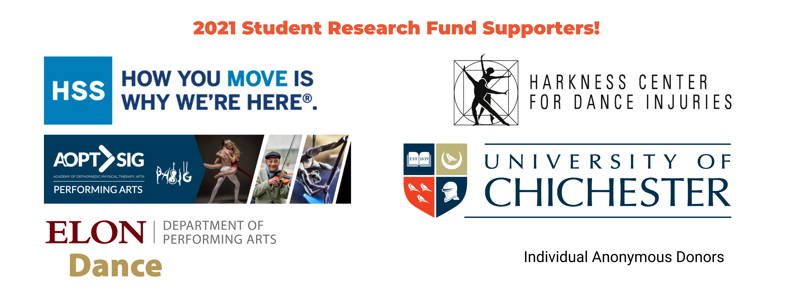Introducing the 2021 Student Research Fund Recipients (Part 1)
The IADMS Research Committee is proud to announce the eight recipients of the 2021 Student Research Fund! Student research abstracts for the IADMS 31nd Annual Conference 2021 were blind reviewed by the Research Committee, evaluating multiple criteria, from methodological merit to originality. The eight recipients have demonstrated outstanding and promising work, and we celebrate them for their accomplishments!
This week on the IADMS blog, we will be introducing the recipients. Be sure to also check out part 2 to hear from all eight recipients and learn more about their research and what receiving the award means to them!
Danielle Kipnis
Title: Dance for Stroke Survivors - A Narrative Review of the Current Evidence
 The purpose of our research was to evaluate and summarize the existing literature investigating dance interventions for post-stroke individuals. Stroke is the leading cause of long-term disability frequently causing motor and cognitive impairments that impact functional abilities. Dance inherently encompasses key principles of motor learning including cognitive-motor specific task practice, sensory feedback, and social engagement. We conducted a scoping review that included 18 publications from 14 studies. Findings from these studies suggested there were improvements in balance, self-confidence, and autonomy after dance interventions for sub-acute and chronic stroke participants. Qualitative studies indicated that dance may encourage confidence, promote comfort with the changed body, increase rehabilitation motivation, and facilitate community reintegration. We concluded that existing but limited evidence supports dance as a feasible and potentially effective intervention for individuals living with sub-acute and chronic stroke. Future research is warranted and should focus on larger sample sizes, optimal intervention timing, dance-specific neural mechanisms, and effective dance class structures.
The purpose of our research was to evaluate and summarize the existing literature investigating dance interventions for post-stroke individuals. Stroke is the leading cause of long-term disability frequently causing motor and cognitive impairments that impact functional abilities. Dance inherently encompasses key principles of motor learning including cognitive-motor specific task practice, sensory feedback, and social engagement. We conducted a scoping review that included 18 publications from 14 studies. Findings from these studies suggested there were improvements in balance, self-confidence, and autonomy after dance interventions for sub-acute and chronic stroke participants. Qualitative studies indicated that dance may encourage confidence, promote comfort with the changed body, increase rehabilitation motivation, and facilitate community reintegration. We concluded that existing but limited evidence supports dance as a feasible and potentially effective intervention for individuals living with sub-acute and chronic stroke. Future research is warranted and should focus on larger sample sizes, optimal intervention timing, dance-specific neural mechanisms, and effective dance class structures.
Receiving this student award is an honor. My team spent countless hours reviewing, analyzing, writing, and editing for this scoping review paper, so we are excited to receive this recognition and see the impact of our work. We hope the award can help us conduct future research that begins to fill some of the gaps our scoping review identified, such as conducting dance intervention studies that evaluate larger sample sizes and optimal intervention timing.
Mackinsey Shanan
Title: Assessment of eating behaviors, nutrition knowledge, and availability of nutrition education and resources for college dance majors
 This research study aimed to identify specific disordered eating behaviors, sources of nutrition information available, and nutrition-related knowledge gaps of college dance majors in the United States. We found that half of all college dancers were at high risk for an eating disorder and most were regularly engaging in a number of harmful disordered eating behaviors, particularly excessive exercise to lose or control weight and binge eating. Most dancers reported some form of restrictive eating, were terrified of being overweight, and were preoccupied with weight-related thoughts. Despite this, access to nutrition education and resources was limited with the majority of college dancers never completing a nutrition course or meeting with any health professional regarding nutrition. While nutrition support may be available on college campuses, nearly 60% of dancers were unaware if there was a dietitian available to them if needed. This lack of access to nutrition was reflected in low nutrition knowledge levels, which were found to be significantly related to the risk of eating disorders. Based on our results, it is evident that college dance programs need improved access and awareness of nutrition information and resources for their dancers.
This research study aimed to identify specific disordered eating behaviors, sources of nutrition information available, and nutrition-related knowledge gaps of college dance majors in the United States. We found that half of all college dancers were at high risk for an eating disorder and most were regularly engaging in a number of harmful disordered eating behaviors, particularly excessive exercise to lose or control weight and binge eating. Most dancers reported some form of restrictive eating, were terrified of being overweight, and were preoccupied with weight-related thoughts. Despite this, access to nutrition education and resources was limited with the majority of college dancers never completing a nutrition course or meeting with any health professional regarding nutrition. While nutrition support may be available on college campuses, nearly 60% of dancers were unaware if there was a dietitian available to them if needed. This lack of access to nutrition was reflected in low nutrition knowledge levels, which were found to be significantly related to the risk of eating disorders. Based on our results, it is evident that college dance programs need improved access and awareness of nutrition information and resources for their dancers.
I am honored to have this opportunity to present my research with IADMS and share my work on nutrition for dancers with the dance medicine and science community. Receiving this award will go to supporting my future research in this area.
Natsuki Yoshida
Title: The effect of pointe shoes condition on the landing impact and postural stability in female ballet dancers
 Pointe shoes are essential for ballet dancers to protect their feet and the use of pointe shoes has been reported to affect performance, however, kinetic and kinematic effects of the changes in footwear on the dancers’ feet are unknown. The aim of this research was to investigate how the shoe condition influences the landing impact and postural stability in single-leg drop-landing maneuvers. We collected ground reaction force (GRF) data during landing in two shoe conditions; short-use time (new shoes) and long-use time (old shoes). Only on the non-dominant side, the mean value of peak vertical GRF and center of pressure trajectory length from 20 to 200 milliseconds in new shoes condition were significantly greater than that in old shoes. Under the same shoe condition, the landing leg did not influence the performance variables, but the high material stiffness of new shoes may result in a lack of impact absorption and postural instability in the initial stage of foot impact only for the non-dominant leg.
Pointe shoes are essential for ballet dancers to protect their feet and the use of pointe shoes has been reported to affect performance, however, kinetic and kinematic effects of the changes in footwear on the dancers’ feet are unknown. The aim of this research was to investigate how the shoe condition influences the landing impact and postural stability in single-leg drop-landing maneuvers. We collected ground reaction force (GRF) data during landing in two shoe conditions; short-use time (new shoes) and long-use time (old shoes). Only on the non-dominant side, the mean value of peak vertical GRF and center of pressure trajectory length from 20 to 200 milliseconds in new shoes condition were significantly greater than that in old shoes. Under the same shoe condition, the landing leg did not influence the performance variables, but the high material stiffness of new shoes may result in a lack of impact absorption and postural instability in the initial stage of foot impact only for the non-dominant leg.
I am truly honored to receive the Student Research Award and would like to express my sincere gratitude to IADMS and all people who supported me. This is my first award I have achieved and has encouraged me to keep pursuing my curiosity about dance medicine. In order to spread the great advantages of dance and increase the number of people who can enjoy dancing without injury, I would like to promote research that leads to performance evaluation and injury prevention in all fields of dance, not only ballet but also street dance and social dance.
Pranav Khambete
Title: Prevalence of Asymptomatic Talar Bone Marrow Edema in Professional Ballet Dancers: Preliminary Data from 2-Year Prospective Enrollment Study
 The purpose of our study is to determine the prevalence of bone marrow edema in the tali of asymptomatic professional ballet dancers. Bone marrow edema is a phenomenon seen on magnetic resonance imaging (MRI) that is commonly associated with performance limiting injuries such as stress fracture in the general population. Our research team believes that this radiological phenomenon may be common in elite athletes such as professional ballet dancers, and that this finding may not necessarily indicate that the dancer has a performance limiting injury. Our preliminary findings suggest that there is a high prevalence of bone marrow edema in dancers without pain or evidence of stress fracture in the foot and ankle. We will continue this study over the course of two years with the hope of following dancers with bone marrow edema and seeing how the lesions progress or regress over the performance season and offseason, and to characterize the risk of developing stress fracture in these athletes.
The purpose of our study is to determine the prevalence of bone marrow edema in the tali of asymptomatic professional ballet dancers. Bone marrow edema is a phenomenon seen on magnetic resonance imaging (MRI) that is commonly associated with performance limiting injuries such as stress fracture in the general population. Our research team believes that this radiological phenomenon may be common in elite athletes such as professional ballet dancers, and that this finding may not necessarily indicate that the dancer has a performance limiting injury. Our preliminary findings suggest that there is a high prevalence of bone marrow edema in dancers without pain or evidence of stress fracture in the foot and ankle. We will continue this study over the course of two years with the hope of following dancers with bone marrow edema and seeing how the lesions progress or regress over the performance season and offseason, and to characterize the risk of developing stress fracture in these athletes.
I am honored to receive this award from IADMS. As a medical student going into orthopaedic surgery, I aim to make research a core aspect of my clinical practice, with the hope of treating elite athletes including ballet dancers to compete and perform to their limits. This award allows me to continue to pursue my research interests as I finish medical school and continue to residency.
The Student Research Award program is only possible thanks to the generosity of our 2021 Student Research Fund Supporters.
